Publications
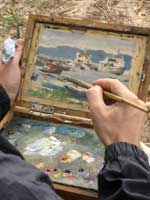
The art of Petersburg painter Anton Anatolievich Ovsianikov is indissolubly linked with the great traditions of realistic school of painting, the basic principles of which had found the interpretation in the art of famous masters of the Russian and European art. The main distinguishing feature of artist’s works is the aspiration towards the reliability and elevated spirituality in depiction of the nature in the whole diversity of its manifestations. It is no mere chance that precisely a landscape had become that genre, where the artist’s picturesque talent was realized with the greatest fullness and brightness.
The period among the completion the artistic specialized school named after N. K. Rerih in 1992 and entering the painting faculty of the St. Petersburg State Academic Institute of Painting. Sculpture and Architecture named after I. E. Repin for the future artist was marked by the final chose of the way of art, by the determination of his own preferences in art and by the propounding of significant tasks to be solved. In the process of study in Academy of art he had acquired the necessary professional experience not only from his teachers but also from the greatest masters of the realistic art of preceding epochs, making himself familiar with the invaluable art collections of the Hermitage, the Russian Museum, Tretyakov’s Gallery and famous European museums.
In diploma picture «Theophany» (2002) entirely revealed itself the artist’s mastery of compositional decision in depiction of the genre theme included in the space of panoramic landscape. The choice of the subject of diploma picture was determined inwardly by the ideals of artist himself. This picture was awarded with the praise of the State attestation committee. In 2002 the painter also entered the post-graduate course of the Academy of arts. He graduated from the post-graduate course three years later (the final exhibition of Anton Ovsianikov’s works was awarded with the highest mark).
The particular place in painter’s art belong to the woks, created as the result of the several trips in Greece — the cradle of European culture, the homeland of the Orthodoxy, the country with which the painter has indissoluble spiritual connection. In the pictures «The Place of Revelation to St. John the Theologian. The Cave of Apocalypsis. The Patmos Island. Greece» (2005), «The Pantanasses. Monastery. Mistra. Greece» (2006), «The St. Dimitriy’s Church. Mistra. Greece» (2006) the architecture of Orthodoxy churches is looking as the inalienable part of beautiful Mediterranean landscape. Here as well as in the works «A Sea Shore. Halkidiki. Greece» (2009), «An Greek Olive-trees» (2008) the bright, concentrated colours of the south nature are united with the common smooth golden range of color. This range of color subordinate to itself the bright colour accents and help to reproduce the atmosphere filled with sunlight and warm. The artist depicted with the particular exactness the appearance of the old Orthodoxy churches, the magnificence of which is distinctly showing itself in combination with the unique beauty of the nature of Greece. In the majority of these landscapes in the basis of compositional decision is the correlation of large balanced masses of a land, sky and sea. The deep azure of the latter is frequently appearing as the picturesque dominant of picture. The particular significant for the painter are the works, where the monasteries of the Saint Mount Athos are depicted. Their history count nearly a thousand years. Monasteries, skits and cells are exist harmonically in the dimension of mountain landscape and are looking as silent custodians of religious traditions. Here on a level with a so-called pure landscapes one can meet the works where in the space of landscape the simple genre subject or the figure of a monk («The Midday of Athos», 2006) — that help to reveal the important idea of harmonic unity, merging of a man and nature. In whole the works, forming the «Greece series» are close in picturesque relation to the Greece landscapes created by Vasily Polenov, one of Anton Ovsianikov’s favorite artists. Polenov, the great master of Russian painting, aspired to the truthful, convincing rendering of light and air environment and achieved that accomplished and clear form which is not available to the quick nature sketch.
In Ovsianikov’s Russian landscapes the brightness and contrasts of the colours of south is replaced by reserved gamut, to a certain extent restricting the painter’s palette, but at the same time allowing to achieve the greatest fineness of tones. It is the most characteristic feature of such a works as «The Winter in a Village» (2003), «A Haystack» (2005) and «Winter Day. Oredege River» (2005), where the author is absorbed by the rendering of the subtle differences, contained in the correlation of white, black and gray, determined by the color of winter nature. The beauty of Russian North and the so-called Middle belt imperceptible for the strange glance, but filled with a special poetry, is penetrate revealed in the pictures «In a Pine Forest» (2005), «A Backwater» (2009), «A First Snow» (2006), «A Water-lilies» (2009), «A Road» (2005). It is necessary to say that even in depicting simple views of nature — quite backwaters and reed ponds, frozen reservoirs or pine thicket covered with a thick moss the painter aspires towards not chamber, fragmentary but epical interpretation of selected theme, looking as a part of enormous magnificent world of a nature.
In some painter’s landscapes one can notice the consecutive mastering of pictorial achievements of French masters — the representatives of Barbizon school, who finally confirmed with their art the traditions of realistic landscape, the principles of which had been continued and developed in the Russian landscape painting of the second half of XIX century. The interpretation of genre themes in that Ovsianikov’s works is allowing to remember the pictures of Russian Peredvizhniks and their contemporaries — Munkachi, Grigoresiku and another masters of the national schools of painting of that time, who had aspired towards the truthful depiction of a rural life as aesthetic significant phenomenon.
In such a landscapes as «The Returning of a Herd of Cows» (2005), «In a Yard» (2004), «Summer Day» (2004), which had become the result of the trip to Mordovia in the simple genre theme Anton Ovsianikov following the masters of Barbizon school Dobigni and Troyon reveals the content of regular organization of the rural life, close to the slow rhythm of natural life. It is necessary to underline that these themes had been always close to the artist who in his childhood all summer leaved in the village and on his own experience perceived the singular beauty of a peasant labor, which is worthy of truthful depiction in the works of art.
The interest to the achievements of Barbizon school can be traced also in some works, created after the trip to Kazakhstan in 2007. In the pictures «The week-days of Gailau» (2007), «A Herd of Cows on a Shore of Ily River. Kazakhstan» (2007), «On a Watering-place» (2007) the austere, distinct picturesque manner is helping to achieve the sensation of a special tangibility of texture, the weight of a form, owing to it the reliability in the rendering of the structure of life of the inhabitants of Gailau — the vast pastures in Kazakhstan was attained. Here the painter also does not aspire towards the underlined individual rendering of a natural theme, and seems to subdue himself to the unaffected beauty of nature, which is necessary to reveal and to embody convincingly. Here one may remember also some works of Vasiliy Vereshchagin, created as the result of a sojourn in Asia and with prodigious exactness reflected the ethnographical peculiarities of Asian people’s set-up. The mastery of picturesque generalization is allowing to Ovsianikov to convey characteristic precisely to a certain place condition of air environment, seeming to underline the unrivalled beauty of mountains in the pictures «Autumn Day. Malaya Alma-Atinka» (2008) and «On the Bolshoe Alma-Atinskoe Lake» (2007), «A Plateau Ush-Conyir. Kazakhstan» (2008). Owing to the using of a light and air perspective, based on the exquisite colour and tone correlations the uncommon persuasiveness in depiction of a mountain landscape is achieved here. The latter is broadly revealed before the viewer in all its magnificence, or is only visible through the golden leaves of trees framing the river rapidly running over the stones.
The greater freedom of execution is characteristic for the city landscapes, painted by Anton Ovsianikov as the result of the trip to Italy in 2002. In the series of works commemorating the sights of Florence and Venice the using of dense local colours, less cultivated in the tones, a certain convention in depiction of buildings create the rigid rhythmical structure, close to the appearance of old Italian towns. It is necessary to notice that later Ovsianikov had not appealed to the genre of a city landscape. At the same time one can meet among his works the portraits and still-lives, where the painter following the traditions of Old masters uses the mars coloured foundation, allowing to enrich make the surface of a canvas into a whole and to impart the depth and solidity to the portrayal. In the «Portrait of a Father» (2002) and in the picture «Masha» (2005) the evocative characteristic and form of a plastic embodiment of a latter forces to remember the portrait painting of the Old masters of XVII century. The austere solemnity of the still-lives created by Surbaran and Rivera — the greatest masters of a Spanish school of painting of Sixteenth century — are revealing themselves also in the way of picturesque decision of such a works as «a Still-life with a Coffee-mill» (2003), «An Old Utensils» (2006) and «A Still-life with an Old Wineskin» (2009). These still-lives are distinguished by the distinct drawing, a special reliability in rendering of texture of a material and the technique of allocation of the sternly organized group of things against the dark neutral background with a bright purposeful light. A fineness of picturesque decision of a rather small bunch picture «Astres» (2006) forces us to remember the still-lives of Fanten-Latour — French painter, who, continuing in his art the realistic principles of the middle of XIX century, had become one of creators of impressionism.
Against the maximum dynamical and complex picture of development of modern art, where, it seems, the objective criterions of appreciation of the latter are lost completely, the preserving of traditions of the realistic painting now, in the beginning of a third thousand years, is especially actual and important. It is necessary to notice, that the convincing evidence of a high artistic level of Anton Ovsianikov’s works is the including of two of his canvases («A Reeds», 2001 and «Winter in a Village», 2003) in the album «Landscape. Russian painting», issued in 2005 by the publishing house «Belyi Gorod». Researching and developing the picturesque achievements of his famous precursors, the artist confirms with his works the beauty and harmony of a universe.
R. А. Bakhtijarov
PhD, the member of Art critics and art historians association (AIS), member of staff of the State Russian Museum
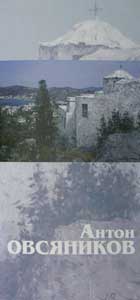 The exactness and trustfulness in the painting had been earlier the great thing in the art, but now, after a long period of the quest for new forms, we are returning to the sources of the Russian academic school and find much to our surprise the consequences of innovatory adoptions.
The exactness and trustfulness in the painting had been earlier the great thing in the art, but now, after a long period of the quest for new forms, we are returning to the sources of the Russian academic school and find much to our surprise the consequences of innovatory adoptions.
Anton Ovsianikov belongs to the painters who preserved in their art the expressiveness and clarity as the distinctive feature of the best examples of the Russian landscape school. But at the same time his manner of painting makes his works well-recognized and contemporary because of their inner expressiveness.
The picture «In a Yard» (2004), showing the well professional skill, refer us to the early works of Ilya Repin, to the sketches for his «Farewell with a Soldier».
But at the same time the landscape «The Winter in a Village» (reproduced in the album «The Landscape. Russian painting», publishing «Belyi Gorod», 2005) and the series of works created as the result of the trips in Greece — works had been executed a year earlier — are showing to a viewer the formed artist with a perfect artistic taste and specific landscape vision, distinguishing that genre from the other ones, sometimes more actual from the social point of view but far more less in lyric and cameral content.
These qualities revealing themselves in Anton Ovsianikov’s works are quite evident and show him the distinctive way in art. Here one can see the ability to work and the quality of painting helping him to create perfect canvases.
A. A. Kugaevsky
Director of «The Petropol» publishers
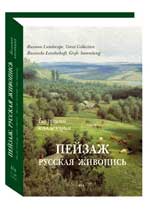 Anton Ovsianikov`s works are included in this album.
Anton Ovsianikov`s works are included in this album.
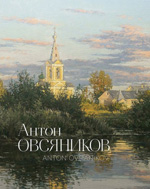
Art is a mirror, and it is not always a plain one. Modern man is accustomed to looking
in the distorting mirrors and seeing there a square eye or a green sun. This modern man is
not surprised at anything. He is not offended anymore or repulsed by anything. Meanwhile,
you only have to step away from the distorting mirrors and look at the world in silence, listen
to it, and you will notice again that nature is simple and majestic. She is not fussy. She is
mighty without pride and beautiful without any embellishment. She is especially beautiful
when there is neither bustling and troubled man nor the trace of his economic activity in the
landscape. We often do not even realize how tired we are of smoking pipes, piles of garbage
and the urban stone jungle. And now we can see before us the world, as though on the sixth
day of creation, when Adam had not yet been created or just come out of the hands of God,
and thus nothing had been spoilt. This is the view of the world the art lovers are supposed
to see in most of the pictures of the proposed album. Man and the works of his hands are
present, of course, in the author’s paintings, but mostly we will meet with the humble beauty
of creation, in which there is no sin. As for man himself, he is present, as always in painting, on
this side of the canvas. With a brush in one hand and a palette in the other, he peers keenly
into the world and then carefully transfers what he understands to canvas.
The name of the
artist is Anton Ovsianikov.
Andrey Tkachev
archpriest
Whatever you say, but the art is not a science. The art is strong only when it is national. One can ask – what about human? Yes, but that human is breaking in art only through the national form...
I. N. Kramskoy
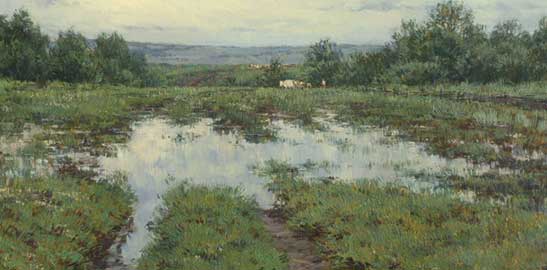
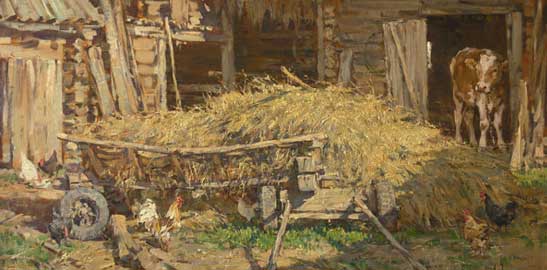
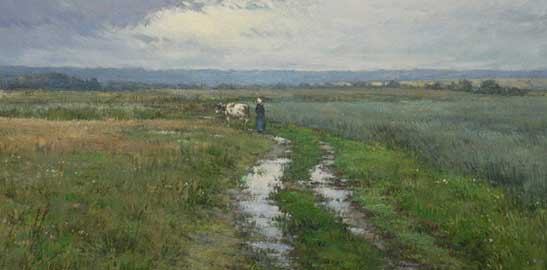
 Tweet
Tweet